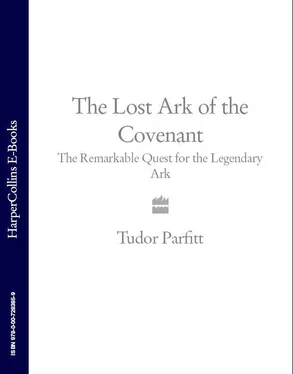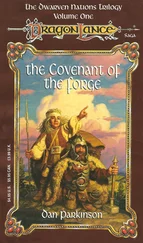‘Guys,’ she said, laying on her Bronx accent, ‘don’t even ask the question! Jerusalem is quiet at the moment. Let’s keep it that way. Anything to do with Temple Mount is a tinderbox! As for the Ark of the Covenant - just leave the poor old thing in peace!’ and she floated off to join Kollek and his guests.
The bar emptied, and around midnight we made our way out onto King George Street. Just before we made our separate ways, Reuven asked, ‘Do you have any spare time?’
‘I suppose I could have,’ I replied grudgingly.
Reuven’s driver was waiting for him on King George Street just a few yards from Finks’. When we got to the car, Reuven opened the door and pushed me in. I got out at Jaffa gate. Reuven wished me goodnight in a preoccupied sort of way and promised he would soon be in touch.
The streets were still full of soldiers. There seemed to be some kind of security alert and I did not feel at ease walking through the dark alleys of the Old City, even though there were checkpoints at just about every corner. I was glad when I got home.
A fresh desert breeze wafted in from the Judean hills as I stood on my roof terrace looking over towards the Dome of the Rock. I could not look at the Temple Mount without thinking of the Ark. I decided to do some reading myself.
For the next couple of weeks I buried myself in the Judaica Reading Room at the Hebrew University and National Library in Jerusalem. The shelves were full of dusty, disintegrating tomes, many of which had been gathered after the Second World War from destroyed Jewish libraries and seminaries throughout Europe. The old library and synagogue stamps from Pressburg, Lodz, and Odessa spoke of hundreds of years of destroyed intellectual endeavour. Many of the Library readers were black-coated orthodox Jews poring over rare rabbinic treatises. Pale-skinned young men with close-cropped hair and thick glasses, they swayed backwards and forwards as they read.
After my weeks in the Library, I passed several days seeing no one and barely leaving the house. This new interest of mine was becoming an obsession and I spent hours poring over my notes trying to make some sense of the Ark. The telephone rang, I did not answer.
As they had not seen me for a while my Arab friends from the suq assumed I was ill and brought me hubiz - flat Arab bread - glistening black olives and hard-boiled eggs. I drank their qahehweh , thick muddy Arab coffee, and pondered the mystery of the Ark.
Over the previous years I had visited Jewish communities throughout the world. I recalled an evening I had spent with the Chief Rabbi of Djerba, an island off the coast of Tunisia. It was around the time of Passover. The rabbi invited me to dinner in a small whitewashed house in the heart of the ancient Jewish quarter called Hara Seghirah. Over dinner the conversation turned to the destruction of the Temple.
He described in graphic detail the sack of Jerusalem, the ruination of the Holy of Holies, the tramp of jackboots over the marble paving stones of the dwelling of the Most High. And as he described this national disaster, he wept. The tears flowed down his haggard cheeks and on to his straggly white beard.
Rabin, I thought, was right about one thing. If the Ark had been destroyed either by the Babylonians or by the Romans, Jews would indeed still be lamenting it.
And the idea that Jews would have done anything and everything to save precious pieces of their heritage was also confirmed by what I learned in Djerba . The venerable rabbi told me that a group of priests had fled to the North African coast after the destruction of Jerusalem by the Babylonians, founding the Djerba community and bringing with them a door and a stone rescued from the Holy of Holies. The stone can be seen to this day. There was no tradition of the Ark going to Djerba, but priests had taken what they could salvage of their spiritual heritage .
‘ Follow the priests ,’ Rabin had said .
It was February 1993 and Jerusalem was beginning to enjoy an early spring. I sat one morning in my small courtyard, under the lemon tree, surrounded by pots of cyclamen and smallleafed basil and tried to summarize in my mind what was historically known about the Ark up until its disappearance from King Solomon’s Temple in Jerusalem.
Once the Israelites under Moses’ command had escaped slavery under Pharaoh and crossed the Red Sea, they made their way into the Sinai Desert. On the first new moon after their escape they camped in front of Mount Sinai. God commanded Moses to climb the mountain to receive the Law.
Having received the Law in the form of the Te n Commandments engraved upon stone tablets ‘by the finger of God’, he descended the mountain to discover that the Israelites were worshipping a statue of a golden calf. In fury, Moses smashed the tablets, and was commanded by God to create a new identical set himself.
The Te n Commandments formed an essential part of the ongoing agreement or covenant between God and the Israelites. Moses was given instructions by God to build the Ark of this covenant, in which the stone tablets incorporating the covenant would be placed.
There are two quite different biblical descriptions of the construction of the Ark.
The first description has the Ark constructed by Bezalel, the artist, upon the orders of Moses. The box was covered all over with the purest gold. Its lid (the kapporet) known in English as the ‘mercy seat’, was surrounded with a rim of gold. On its lid were golden cherubim whose outstretched wings formed an arch above the lid. There were two gold rings on each side through which carrying poles could be inserted.
The second version of the construction of the Ark is simpler. According to the book of Deuteronomy, it was Moses himself who made the Ark, and the Ark was a totally different kind of object. It was just a regular wooden box. There is no mention of nails, or of joints, or of glue. So perhaps it was simply a kind of recipient hollowed out of the trunk of a tree with a knife or chisel.
The Ark, in both forms, was made of acacia wood - shittim wood in Hebrew. In many arid zones in Africa, the acacia is the archetypal tree. In the Sinai desert - the land bridge between Africa and Asia - the acacia species rules supreme. It would have been just about the only building material available in the wilderness.
The wood of the acacia is exceptionally hard, very heavy, very dense, and will last for a long time. In desert conditions, it would not perish. In Egypt there are acacia panels which have survived for well over 3000 years.
Under the right conditions the Ark could virtually last forever.
The Ark was 2.5 cubits long, 1.5 cubits wide and 1.5 cubits high which translates as about two foot wide, two foot tall and just under three foot long.
It was about the size of a large suitcase.
It was easily transportable, easy to hide.
But what was it for? The Ark’s first purpose was to serve as a receptacle for the stone tablets. The second was to serve as the throne of God, who was visualized as sitting just above the outstretched wings of the cherubim. The lower part of the Ark was seen as the footstool of God.
In whichever form the Ark was made it was placed in a tent shrine called the Tabernacle. Soon after, Aaron, Moses’ brother, brought sacrifices for the Lord. He prepared his sacrifices according to the letter of the law, but the sacrifices were consumed by a fire, but not by a fire that had been prepared by him .
The fire just happened.
And later his sons Avihu and Nadav made improper offerings not done according to the letter of the law. They brought the wrong sort of fire before the Ark, and its fire killed them.
Читать дальше












